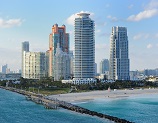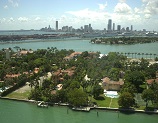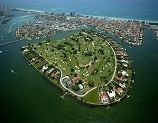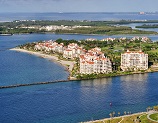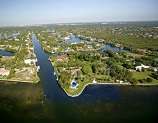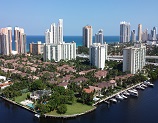Getaways: 10 Great Destinations to See Before it’s Too Late
RISMEDIA, March 3, 2008-(MCT)-That dream vacation-diving along the Great Barrier Reef, skiing in the Swiss Alps-could remain a dream forever if you don’t get a move on.
The brilliant coral off the coast of Australia could be largely gone by 2050, says a 2007 report by the Intergovernmental Panel on Climate Change. And the cost of snowmaking equipment in the Alps is already forcing operators to invest in more snowmaking equipment, says Forbestraveler.com. The attention lately focused on these changes, and the overall issue of global warming, has already prompted one latter-day oracle to predict we will travel differently in 2008 and beyond.
“Let’s face it, Al Gore’s “An Inconvenient Truth” and the time-lapse photography were not lost on a number of people,” says Ann Mack, director of trend spotting for JWT, the nation’s largest advertising agency. “And increasingly, people are wanting to see these sights of the world before they change shape or change form. As global warming is rising up the world’s agenda, ecotourists are flocking to previously ignored places.”
It’s been called climate sightseeing, a kind of farewell tour of Earth’s greatest hits. Hard data is not available-determining exactly why people go where they do is next to impossible. But a clear interest in ecotourism, coupled with much greater accessibility to places like the Earth’s poles, means more people are visiting faraway and endangered sites, whatever their motives.
The subject is full of paradoxes: The more you travel, for example, the more you’re contributing to the problem that made you go to an endangered site in the first place. And some places-Canada, perhaps Russia and other cold climes-are likely to attract more tourists as they warm.
Robert Henson, a meteorologist at the National Center for Atmospheric Research and author of “The Rough Guide to Climate Change,” says: “Stay longer. Go ahead and travel, but do it smartly. Get direct flights; use a train to get around.”
Here is a short list of places that scientists and key reports say are feeling the effects of global warming today-places to consider as you put together your travel plans.
1. U.S. Glacier National Park, Montana
Scientists say the glaciers will all be gone by 2030. Henson says
new names were even tossed around at one point. Glacier Morain National
Park? Glacier Memorial National Park? But the Park Service Website-which
has a sense of humor about it all, with a webcam trained on snowmen
wearing sunglasses-says the name will stay the same.
The U.S. Geological Survey has been keeping a close eye on Glacier for a long time- the park is the site of one of the nation’s most important research programs on climate change. Photos from the early 1900s up to today show glaciers receding for decades-and the weather there is on a wild ride, with record droughts, near-record summer temperatures and near-record snowfall. Though it’s unclear whether this decade’s changes are speeding up the glaciers’ decline, there’s no doubt they’re receding. See for yourself, at http://nrmsc.usgs.gov/repeatphoto/gg_mt-gould.htm.
Glacier is a huge park with more than 700 miles of trails through
pristine forests.
Online: To see the snowmen and learn about the park, www.nps.gov/glac/index.htm
2. Alaska
Most of the many glaciers here are also receding, with a few minor exceptions, and have been for 15-20 years, says Ron Peck, president of the Alaska Travel Industry Association. The traveler’s challenge here may be fighting the crowds. Peck says Alaska counted 1.7 million visitors last summer, up 3% from the previous year.
Likewise, at Dallas/Fort Worth Airport, passengers to and from Alaska increased from 46,070 in 2003 to 85,894 last year, a spokesman says. The numbers grew quickly after Alaska Airlines started serving D/FW in 2005 and have continued to rise.
Travel to Alaska has changed dramatically during the past 20 years, says Steve Cosgrove, owner of Dynamic Travel in Southlake. “The average tour was a salmon bake and a totem pole tour. Now there’s river rafting, scuba diving-it’s a completely different experience now.”
A lot of people arrive on cruise ships-in 2006, Alaskan ports had 3.3 million cruise passenger visits (that’s probably about three times the actual number of passengers, because each passenger visits several ports on a cruise.)
Online: www.travelalaska.com; also, www.alaskaair.com for Alaska Airlines; and most major cruise lines travel to Alaska
3. Western pine forests
This is mostly the fault of the mountain pine beetle, “a little critter that gets in and messes with the flow of the sap to the tree,” says Henson, who lives in Colorado. These beetles have been running amok lately, in parts of the West that haven’t had consecutive cold winters. And they’re on the move over the Continental Divide from western Colorado, Henson says.
Already, Henson says he sees big stretches around Aspen and Glenwood, Colo., on U.S. 70 west of Denver, where the trees’ pine needles are red. This isn’t a normal change. The trees are dying, and they won’t regrow for decades. Henson says that aspen trees will seize the opportunity to flourish. Visually speaking, it’s not a bad thing to see dazzling displays of aspen in the fall, but a lot of Coloradans and visitors are partial to pine trees, especially North and West Texans who don’t get to see too many of them. The pines will probably return, but 10 to 20 years after they die off.
Online: www.colorado.com
4. New England
Henson says a “fair amount” of research shows the sugar maples so beloved for their brilliant foliage and maple syrup are in some danger during the next few decades. On the other hand, a report in July by scientists in Cambridge and the Union of Concerned Scientists says the hardwoods that make up the classic New England forest scenery “may be able” to last the century. Spruce and fir trees are in more danger of going away over time.
Either way, the forests themselves would change “dramatically” as temperatures rise and different trees become dominant, the report says. Some of the area’s songbirds are likely to take flight for cooler climes _ the song sparrow, Bicknell’s thrush, Baltimore orioles. Other species like the great horned owl might not be affected and might even increase. And delicious New England maple syrup? Some production already has shifted to Canada, for technological and tree-related reasons, Henson says.
Any changes in the region’s forests will have a huge impact-tourism and forestry contribute billions to the economy, the report says.
Online: www.gonewengland.com
5. New Orleans
It’s been sitting on a swamp for years, and that’s not going to get any better. Henson also worries about the impact of recovery from Hurricane Katrina: “The Netherlands is already kind of resigned to the fact they’re going to have to build giant dikes around the country,” he notes. “New Orleans is more in the classic rebuilding mode.”
Without getting into the political problems that may have hindered the city’s recovery, suffice to say climate change is going to pick up the pace of any encroaching water. The French Quarter has been fine to visit since shortly after Katrina, with plenty of the renowned, great restaurants and hotels open. Henson was in the Crescent City in late January, and said a two-hour Gray Line tour is a great way to see what’s happened and how recovery is progressing. Travelers who like to give back to their destinations still have plenty of voluntourism opportunities-city residents still need help rebuilding homes, for example.
Online: www.nola.com
6. The Florida Everglades
According to the Natural Resources Defense Council, an environmental action group, at www.nrdc.org, “the anticipated 2- to 3-foot rise in sea level over the next 100 years will cause salt water to flow 10 miles or more inland _ right into the Everglades.” Researchers also are predicting more tropical storms, which is more bad news for Florida.
The vulnerable and fragile Everglades are on travel.msn.com’s list of “World’s Endangered Destinations” and mentioned frequently in climate change discussions, because they are changing in ways that could happen in other coastal areas.
Online: Everglades National Park, www.nps.gov/ever
Outside the U.S.:
7. Polar regions
There’s no doubt change is afoot at opposite ends of Earth-to the north, the Greenland ice cap is melting faster than expected. “Depending on who you ask,” Henson says, the entire Arctic Ocean could be open water in the summers in 100 years or so. A complete lack of sea ice would mean big problems for polar bears, not to mention, well, probably the rest of us. The polar bear cause became popular after former Vice President Al Gore’s “An Inconvenient Truth” was released, and tours are common.
In Antarctica, some penguin species have declined for the same reason, but whether the temperature increases are human-caused is still being debated. At any rate, between Gore’s movie and a spate of penguin films in the last few years, trips to Greenland, Norway and Antarctica have become all the rage.
“I know that we have seen tremendous growth in our expeditions to the polar regions (Antarctica and the Arctic),” says Jennifer Gregoire, media relations manager for Lindblad Expeditions, via e-mail. The voyages have been sold out far in advance, prompting the company to purchase a second ship for the polar regions. The National Geographic Explorer is expected to set sail in June.
Denise Landau, executive director of the International Association of Antarctica Tour Operators, says the increase has nothing to do with climate sightseeing: “It’s a fantastic place to go, more vessels available for people to travel on, and there are more companies who are established around the world. I’ve actually gotten that question a lot, and our operators don’t believe it has anything to do with global warming.”
Online: www.nationalgeographicexpeditions.com; www.iaato.org
8. Low-lying islands
A tiny Polynesian island nation called Tuvalu already has discussed evacuation plans if the sea continues to rise. Tuvalu made the travel.msn.com list, as well as “An Inconvenient Tour” at www.ecotravellogue.com. Says that Website: “Although Tuvalu’s population of 12,000 makes it the smallest country by population represented in the United Nations, the series of atolls in the Pacific has become something of the human face of global warming and has been used as an example of the effects of rising sea-levels over and over in international media and in speeches to the UN.”
Getting there is a little complicated _ you’ll have to fly first to Suva, Fiji, and then on to Funafuti, Tuvalu. The attraction, beyond seeing possibly the world’s most endangered island, is snorkeling and scuba diving. Also the wrecks of American aircraft and other detritus are visible in the waters _ troops were stationed there during World War II.
The Maldives, a group of low-lying atolls in the Indian Ocean that are popular with scuba divers, also are mentioned often in the context of global warming. A forbestravel.com list of endangered places says they were named a prime example of a top tourist destination at risk in “Places to Visit by 2020,” a 2006 report by the British Centre for Future Studies.
Online: www.timelesstuvalu.com and www.visitmaldives.com
9. The Great Barrier Reef, and coral reefs in general
Warmer oceans mean stressed coral, which results in bleaching and death. This isn’t news to anyone who dives or snorkels regularly. A 2007 report by the Intergovernmental Panel on Climate Change shows it’s likely to continue as temperatures keep rising.
The Great Barrier Reef off the coast of Australia is the world’s largest, and many reports a few years ago warned of its death within a few decades. The 2007 report suggests the reef could be dominated by “non-coral organisms” by 2050.
Online: www.coralreef.noaa.gov for a U.S. coral conservation program
10. The Alps
A lot is in store for the parts of Europe many Americans like to dream about, at least according to some reports. The Swiss Alps are already less snowy; and malaria is reappearing in Spain and could become more prevalent as warmer temperatures create a better habitat for certain mosquitoes, according to a 1999 Wildlife Fund report on climate and tourism.
The lack of snow in the Alps is forcing smaller operators who can’t afford large investments in snowmaking equipment out of business. Glaciers there are melting as well, so both the ski scene and the scenery will be changing in the next several decades.
Online: www.myswitzerland.com
How to Help the Earth Little by Little
Yes, emissions from aircraft and automobiles are huge contributors to the greenhouse effect. But you can at least try to help with the solution even as you strike out for faraway places. Here are some ideas:
1. Take fewer flights and stay longer each time.
2. Find vacation destinations that are closer to home.
3. Consider trains and boats. Go to www.seat61.com for information
on how to get almost anywhere on them.
4. Give up the red-eye and fly during the day-contrails, the plumes
of exhaust from airplanes can help cool the Earth by blocking sunlight
but only during the day, meteorologist Robert Henson says.
5. Find out what kind of aircraft you’ll be on and choose a
newer one if possible-newer airplanes are generally more efficient.
Try www.seatguru.com for the information.
6. Pack light-heavy suitcases contribute to fuel consumption.
7. Consider what kind of trip to book. For example, www.responsibletravel.com
has a 10-day trip to Peru in which participants help build wood stoves,
or another to the Arctic in which travelers help investigate carbon
levels.
8. Change the way you drive-turn off the car instead of idling, brake
and accelerate gradually and follow the speed limit.
9. Stop drinking bottled water-fossil fuels are used to manufacture
the bottles.
10. Use carbon offsets. If you’re worried about whether they’re
really doing any good (offsetters are not tightly regulated), check
out recommendations at www.cleanair-coolplanet.org and www.climatefriendly.com.
Sources: “The Rough Guide to Climate Change” by Robert Henson ($16.99, Rough Guides) and www.responsibletravel.com
© 2008, Fort Worth Star-Telegram.
Distributed by McClatchy-Tribune Information Services.




